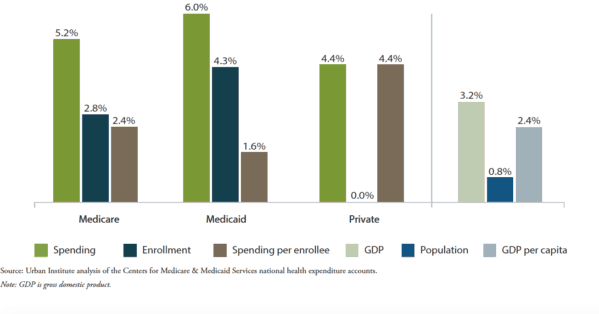
According to a federal report issued yesterday by the Centers for Medicare and Medicaid Services (CMS), government is expected to cover 47% of the country’s health care costs by 2027. The current figure is 45 percent, according to the Associated Press.
“Rising prices for health care goods and services are expected to account for nearly half the spending growth, said the report, with the rest driven by a mix of factors, including an aging population… ‘The baby boom generation is expected to shift from private health insurance coverage to Medicare coverage during the projection period,’ said an author of the report.” – Associated Press, 2/20/19
However, as today’s Washington Post points out, the rise in government spending on health care should not come as a surprise given the continued aging of America:
“The number of people covered through Medicare — and spending on the federal insurance program for older and disabled Americans — is expected to grow more rapidly than private insurance… eating up a larger chunk of health spending.” – Washington Post, 2/21/19
In fact, argues one health care analyst, only an alien would truly be shocked at the latest projections from CMS:
“To the extent that a Martian landed and saw how much of the American health care system is funded by the government, it’s been about 50 percent for some time,” – Paul Hughes-Cromwick, economist at the nonprofit research organization, Altarum
Others are flat-out skeptical about the CMS projections, including President Obama’s former budget chief, Peter Orszag:
“They have predicted an imminent acceleration of health-care costs repeatedly over the last few years,” he said. “It hasn’t happened, and there’s no reason to expect it’s about to.” – Washington Post, 2/21/19
Even if these projections are on the money, they can be somewhat misleading out of context. While overall government spending on health care may rise in the future due mainly to the nation’s changing demographics, federally-run programs like Medicare remain the most cost-effective means of providing care.
A new report from the Urban Institute found that Medicare spending per beneficiary between 2006-2017 was “equal or less” to the increase in per capita GDP. On the other hand, private insurers spent two percentage points more per capita during the same period. Translation: Medicare spends more efficiently on health care than private insurers do. Even if overall government health care spending rises because of an increasingly aging population, Medicare costs less per person.
In this graph from the Urban Institute report, the brown bars represent spending per enrollee:
“Overall, Medicare and Medicaid are doing a good job of keeping per capita costs under control, and the continuation of recent policies is critical to sustain this control… The authors conclude that [both programs] have successfully moderated growth in spending per enrollee… and do not require major restructuring to lower national health spending.” – Urban Institute Report
The report’s conclusion refutes conservative proposals to cut Medicare, especially when there are more equitable, common sense, and non-Draconian measures available to lower costs. The new Democratic majority in Congress is already examining potential solutions – including allowing Medicare to negotiate drug prices directly with Big Pharma. Meanwhile, Medicare ‘reformers’ should take note of this other nugget in the Urban Institute report: “The larger cost containment problems the nation faces are in the private insurance market.”



